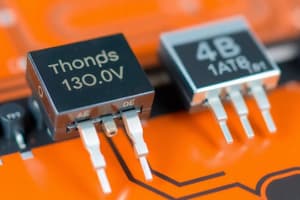Podcast
Questions and Answers
Which Intel processor was the first to introduce MMX technology?
Which Intel processor was the first to introduce MMX technology?
- Intel Pentium III
- Intel 80486
- Intel Pentium Pro
- Intel Pentium II (correct)
Which Intel processor had a clock speed of 1GHz?
Which Intel processor had a clock speed of 1GHz?
- Intel Pentium Pro
- Intel Pentium IV
- Intel Pentium II
- Intel Pentium III (correct)
Which Intel processor had all internal connections made from aluminum to copper?
Which Intel processor had all internal connections made from aluminum to copper?
- Intel Pentium III
- Intel Dual Core
- Intel Pentium II Xeon
- Intel Pentium IV (correct)
Which Intel processor was designed for servers?
Which Intel processor was designed for servers?
What is the function of the RD and WR lines in a microprocessor?
What is the function of the RD and WR lines in a microprocessor?
What is an ALU in a microprocessor responsible for?
What is an ALU in a microprocessor responsible for?
How does the program counter differ from registers A, B, and C in a microprocessor?
How does the program counter differ from registers A, B, and C in a microprocessor?
What is the purpose of the clock line in a microprocessor?
What is the purpose of the clock line in a microprocessor?
What is the function of a tri-state buffer in a microprocessor?
What is the function of a tri-state buffer in a microprocessor?
What is the role of the instruction decoder in a microprocessor?
What is the role of the instruction decoder in a microprocessor?
How many tri-state buffers are marked as '3-State' in the diagram?
How many tri-state buffers are marked as '3-State' in the diagram?
What does the instruction register latch the value currently on?
What does the instruction register latch the value currently on?
Which lines tell the A register and B register to latch the value currently on the data bus?
Which lines tell the A register and B register to latch the value currently on the data bus?
What do the RD and WR lines control in a microprocessor?
What do the RD and WR lines control in a microprocessor?
What does the address bus in the microprocessor do?
What does the address bus in the microprocessor do?
What happens when the RD line changes state in the ROM chip?
What happens when the RD line changes state in the ROM chip?
What is one issue with today's RAM chips mentioned in the text?
What is one issue with today's RAM chips mentioned in the text?
What is stored in ROM and what is its significance?
What is stored in ROM and what is its significance?
Flashcards are hidden until you start studying
Study Notes
Intel Processors
- The first Intel processor to introduce MMX technology was the Pentium MMX.
- The Intel processor with a clock speed of 1GHz was the Pentium III.
- The Intel processor that changed internal connections from aluminum to copper was the Pentium 4.
- The Intel processor designed for servers was the Xeon.
Microprocessor Components
- The RD and WR lines control data transfer between the microprocessor and memory.
- The Arithmetic Logic Unit (ALU) is responsible for performing arithmetic and logical operations.
- The program counter differs from registers A, B, and C in that it stores the memory address of the next instruction to be executed.
- The clock line synchronizes the operation of the microprocessor.
Microprocessor Functionality
- The tri-state buffer allows multiple devices to share the same bus, but only one device can drive the bus at a time.
- The instruction decoder translates opcodes into specific microprocessor actions.
- The instruction register latches the value currently on the bus, which is the opcode of the current instruction.
Registers and Bus
- The RD and WR lines control when the A and B registers latch the value currently on the data bus.
- The address bus carries the memory address of the data being accessed.
ROM and RAM
- When the RD line changes state in the ROM chip, the data is output onto the data bus.
- One issue with today's RAM chips is that they are volatile, meaning their contents are lost when power is turned off.
- ROM (Read-Only Memory) stores permanent data and instructions, and its significance is that it retains its data even when power is turned off.
Studying That Suits You
Use AI to generate personalized quizzes and flashcards to suit your learning preferences.




